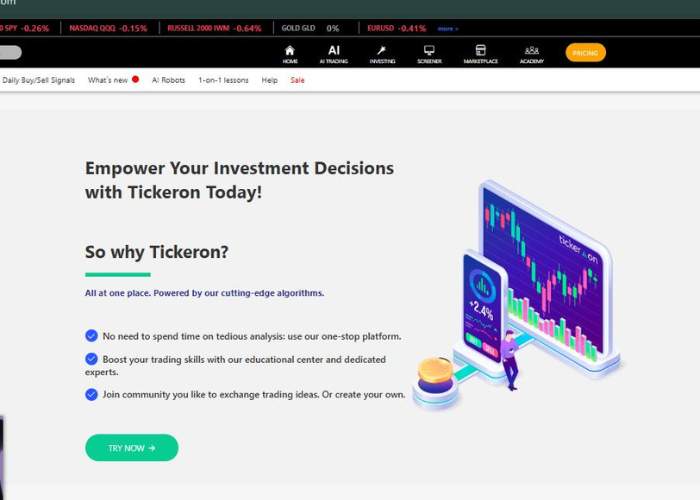You click on Tickeron thinking, “AI trading bot—sounds futuristic,” and then you’re knee‑deep in a dashboard packed with features: pattern recognition, AI robots, signal agents, virtual agents, trend predictors. First thoughts? Impressive. But let’s dig deeper.
What Tickeron Is (and Isn’t)
Tickeron bills itself as a one-stop AI trading platform—think pattern scanners, AI robots, forecast engines, all under one roof. Perfect for quantitative-minded retail traders wanting to automate analysis and generate real-time signals. Not exactly built for casual stock picking or buy-and-hold investors.
Flashy buzzwords aside, it delivers actual tools:
- Pattern Recognition Engine scans for technical formations in stocks, ETFs, crypto, Forex and ranks them with confidence scores.
- AI Robots come in three flavors:
- Signal Agents: fixed-trade, copy-style bots.
- Virtual Agents: simulated accounts, adjustable balances, money management.
- Brokerage Agents: very advanced, tick-level trade copying (still in rollout).
Onboard also is an AI Trend Prediction Engine, Screener, Time Machine (for backtesting), and a full Marketplace of community portfolios and models.

Feature Tour: More than Just Hype
- Pattern Alerts + Confidence Scores
The AI flags patterns (breakouts, chart setups) and gives both a probability and its internal confidence—handy, though real users say accuracy varies. Some Reddit reviewers tried 20+ signals; none hit their targets, even with purported 90% confidence. Fair warning.
- AI Robots in Action
These aren’t static indicators. You can bookmark, follow, toggle notifications, enable autopilot which feeds trades into your Paper Trade account. Virtual Agents manage risk, adjust trade sizes—they feel more robust.
- Real-Time Metrics Table
| Agent Type | Time Frames | Risk Control | Real/Simulated |
| Signal Agents | 5, 15, 60 min | No | Copy-trade |
| Virtual Agents | 5, 15, 60 min | Yes (money mgmt) | Simulated |
| Brokerage Agents | 5, 15, 60 min | Tick-level risk | Live (future) |
Agent stats include Annualized Return, Sharpe Ratio, Profit Factor, Profit vs Drawdown. They provide both closed and open trade logs.
My Hands-On: Scratching the Surface
I spent a week playing around. I set up follow on a couple Virtual Agents trading tech stocks, got alerts, watched their simulated trades. I also ran pattern scans (Time Machine) on breakout candidates I was curious about. The interface felt intuitive—but still overwhelming at first.
A few moments stood out:
- Received a bullish breakout signal on an ETF, clicked details, saw confidence 85%, value 5% move—but price dropped the next day. That sucked.
- Watched a virtual agent produce decent returns on paper trades. Some days it churned thin wins; other days it stacked bigger returns—all tracked cleanly in dashboard.
- A high-school‑level trader friend asked: “What if I tweak trade size mid‑week?” Virtual Agents let you do just that, which is cool.
Support? The platform has an Academy, tutorials, chatbot. People say they help, but reviews show mixed experiences—especially cancellation or billing issues. A few Trustpilot users report unwelcome billing, difficulty canceling, no refunds.
Pros & Cons Table
| Pros | Cons / Caveats |
| All-in-one platform: patterns, robots, forecasting tools | Accuracy uneven on pattern signals—some users see failures |
| Multiple agents with choice of risk vs simplicity | Steep learning curve if you’re new to quant trading |
| Flexible agents: timeframes (5, 15, 60 min), money controls | Real-money execution still limited to Brokerage Agents |
| Clear stats: Sharpe, drawdown, profit factor, closed trades | Support/billing featuring complaints about refunds and cancelation |
| Simulated autopilot and paper trades to test strategies | Trustpilot score 3.2/5—some users unhappy or claim misleading trial |
Emotional Diary: What It Felt Like
At first I thought: “Wow, look at all these bots!” A little excited. But after my first false‑signal—confidence 90% yet price tumbled—I was deflated. Felt like the AI had confidence, but markets laughed. Then I reminded myself: pattern scanning isn’t a crystal ball—it’s statistical.
After a few days, I warmed to Virtual Agents. Watching a simulated portfolio tick up in real time, with clear performance metrics, felt empowering. It’s like having a nerdy buddy crunch charts while you sip coffee.
That said, when I read real users got charged after cancellation, and the Trustpilot horror stories—felt uneasy. Trust matters when you’re giving a platform money every month.

Pricing & Value
Tickeron plans start around $60/month, and rise depending on access (Signal, Virtual, Expert). Some sources note premium value, but credit-earning toward other tools complicates things.
WallStreetZen suggests for pure stock picks, their Zen Investor annual plan (~$99/year) might be cheaper. But you lose access to the bot toolbox.
If you’re considering just signals or pattern scanning, Tickeron can be heavy overhead. But if you want full AI automation tools, it’s priced competitively.
Final Take: Is It the Best AI Trading Bot Platform?
Tickeron is neither perfect nor the easiest. It’s powerful but messy. For the quant‑curious retail trader, it provides a playground of AI-powered tools. But results vary—some users rave, others warn.
If you’re game to learn, willing to paper-trade first, and not freak out when confidence‑rated signals fail—you might find value. For me, I’d treat it as risk‑managed experimentation zone, not autopilot to riches.
Should You Try It?
- Want AI robots, pattern scanners, live metrics—all integrated? Worth a look.
- Prefer simulated testing before risking real cash? Virtual Agents and paper trades help.
- Hate manual automation? Autopilot might change your workflow.
But if you expect robots to give you a flawless edge—be skeptical. No bot forecasts perfectly. Also, read their cancellation policy before subscribing—some users got burned.
My Parting Advice
Try the free trial/paper trade tools first. Pick a couple Virtual Agents, track their performance, let them simulate trades for a week. Use the Pattern Search Engine sparingly—validate signals before trusting them. And keep an eye on billing, cancellation deadlines.
Tickeron isn’t magic, but it can be a capable assistant if you use it right. It’s like riding a high-performance bike: exhilarating when you handle it well, dangerous if you ignore the road. Let me know if you’d like help picking agents or calibrating filters—happy to talk strategy.


